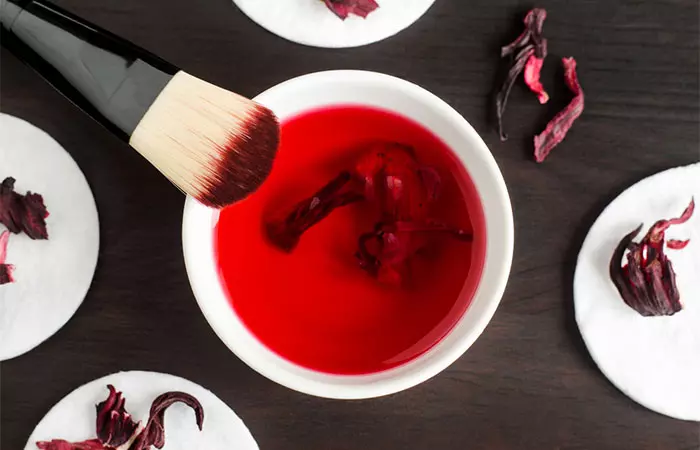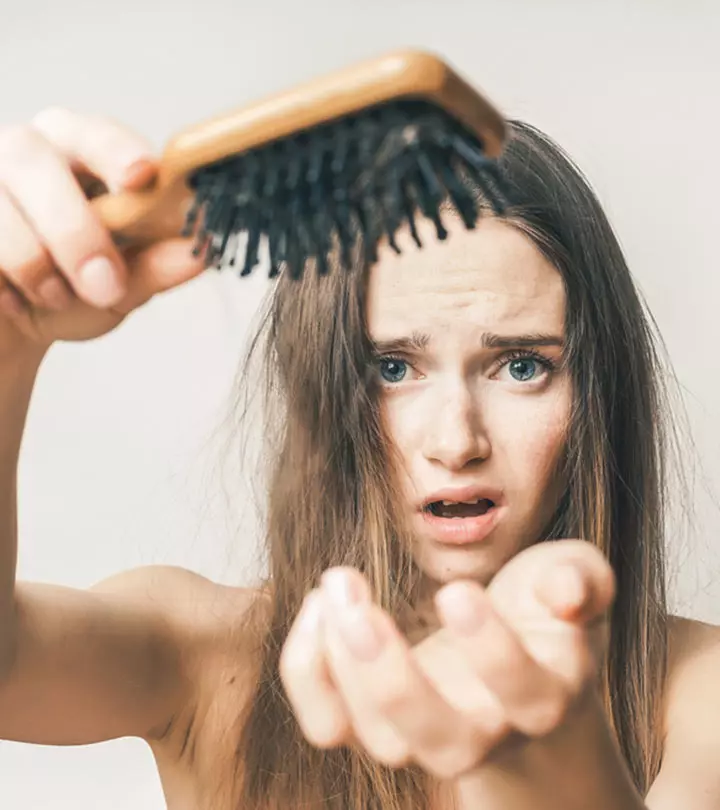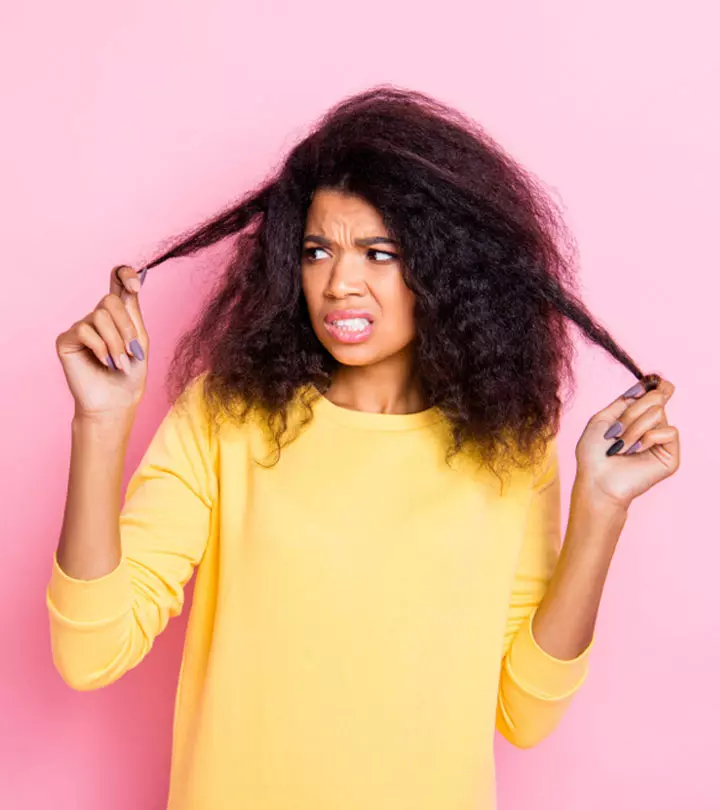6 Ways To Remove Hairspray From Your Hair
Simple hacks that help you avoid the risk of product build-up and greasy scalp.

Image: Midjourney/ StyleCraze Design Team
A hair spray is perfect for styling and managing your hair. Just make sure you don’t forget to remove hairspray from your hair later. Hairsprays can leave behind a residue on your scalp and hair if you use them too often. It clogs the hair follicles and causes itching and hair loss if not removed. You may also experience greasiness, dullness, and hair breakage. Hence, it is important to remove hairspray buildup for better grooming and there are several different ways to do so. Here are some tips. Scroll down.
In This Article
6 Ways To Remove Hairspray Buildup Naturally
Here is a quick safety tip before we get started. Before using any ingredients, always do a patch test to check for allergic reactions or sensitivity. Simply apply a small amount to your wrist and wait 24 hours to see if any irritation develops. Read on to know how to remove hairspray buildup naturally.
1. Dish Soap

Don’t be surprised to see this product top the list. Dish soaps have detergents and can easily remove hairspray buildup. Use a regular dish soap with a mild formula. Spread it on your hair with a comb. Leave it on for at least 15 minutes, and then rinse your hair. For a light buildup, you can also use regular shampoo instead of dish soap.
 Quick Tip
Quick Tip2. Baking Soda

Your regular shampoo alone may not remove hairspray buildup. Try using baking soda for hair instead. Add a tablespoon of baking soda to it and mix well. Spread the mixture on your hair and leave it on for a while before rinsing. You may also rub baking soda directly on wet hair and scalp and wash it off with a shampoo.
3. Clarifying Shampoo

If you use hairspray every day, a clarifying shampoo is the best for removing scalp buildup effectively. Clarifying shampoos contain a high amount of SLS (detergents) that remove any buildup and dirt from your scalp. However, do not use it every day.
4. Apple Cider Vinegar

Apple cider vinegar (ACV) is popularly used as a post-shampoo rinse to maintain hair health. It also helps remove any product buildup or residue. Add a tablespoon of ACV to a cup of water and use it as a final rinse. You can adjust the quantity as per the hair length. Apple cider vinegar also enhances your hair’s beauty by making the hair smooth and shiny.
5. Aloe Vera Gel

Aloe vera gel has moisturizing and cleansing properties (1). Anecdotal evidence suggests that these can aid in breaking down the product buildup on the scalp and regulate excess sebum as well, thereby bestowing you with clean, free-flowing hair. Mix half cup of aloe vera gel, one tablespoon of lemon juice, and a few drops of rosemary essential oil and apply the mixture to the scalp and hair. Leave it on for 30 minutes before rinsing it off with tepid water and a gentle shampoo.
6. Hibiscus

Hibiscus flowers can help combat product buildup on the scalp and hair. They contain mucilage that may have natural cleansing properties. According to anecdotal evidence, these can help balance the scalp’s pH levels and reduce excess oil. Use them as a spray by boiling the flowers and transferring the infused water to a bottle. Spritz a good amount of it on the scalp as well as the hair and leave it on for 1-2 hours before rinsing it off.
The above-mentioned tips can easily remove buildup from your hair and bring back its lustre. However, if you would like to prevent hairspray from building up in the first place, read on and find some helpful tips.
 Quick Tip
Quick TipKey Takeaways
- Just like makeup, it is important to remove hairspray from your hair at the end of the day to prevent residue buildup.
- If you use a lot of hairspray, leaving it in your hair overnight may clog the hair follicles and lead to dull, greasy hair.
- Common household products like dishwashing liquid, vinegar, and baking soda can come in handy in removing hairspray.
Tips To Prevent Hairspray Buildup
Hairspray can be a lifesaver for achieving a desired hairstyle, but excessive use can lead to buildup and damage. Here are some tips to prevent hairspray buildup:
- Limit hairspray use to special occasions or days when you really need that extra hold.
- Choose a lighter formula hairspray to reduce buildup.
- Clarify your hair regularly with a clarifying shampoo once a week to remove residue.
- Use mousse or lightweight styling creams on some days to give your hair a break from hairspray.
- Instead of heavy spraying, lightly mist your hair from a distance to evenly distribute the product without overloading it.
- Brush out your hair at the end of the day to help loosen any residual spray and prevent buildup over time.
- Using multiple styling products on top of hairspray can accelerate buildup, so try to keep your styling routine simple.
- Apply hairspray to the ends of your hair instead of the roots to avoid clogging hair follicles.
If you are using hairspray or any other hair styling product, ensure to wash it off at the end of the day. Leaving it on your hair for too long may damage it. Let’s find out how.
Is It Bad To Leave Hairspray In Your Hair Overnight?

Yes. Most hairsprays and styling products are oil-based. If you do not wash them out before sleeping, they may leave residue on the scalp. The dirt and grease can clog the pores on your scalp, affect the hair follicles, and cause acne and hair fall if the hairspray is left in for too long.
Understanding the role of the ingredients in hairspray can help you make informed choices about the products you use on your hair. Learn more about it below.
Understanding Hairspray Ingredients
Most hairsprays contain a combination of alcohol, polymers, and fragrances.
- Alcohol: It acts as a drying agent to help set styles. However, excessive exposure to alcohol can dry out the hair, leading to brittleness and breakage.
- Polymers: These synthetic substances form a film on the hair, locking in styles. While this is beneficial for achieving desired looks, excessive buildup of polymers can weigh down the hair and make it appear dull.
- Fragrances: They mask unpleasant odors and provide a pleasant scent. However, some fragrances can be irritating to the scalp and contribute to buildup.
Infographic: Natural Ways To Remove Hairspray Out Of Hair
Hair styling products may leave behind a residue on the scalp. It can lead to hair breakage and dryness. There are a few methods discussed above to remove hairspray from your hair. However, if you do not like using soap or detergents on your hair, you may check out the infographic below for the natural ways. Illustration: StyleCraze Design Team
If you have greasiness, dullness, or hair breakage, the culprit could be hairspray buildup on your scalp and hair. Hairspray may be ideal for keeping your hairdo in place all day, adding volume, and taming frizz, but excessive use can leave debris on the scalp, drag down the hair, and cause hair fall. To counteract hairspray buildup and keep your scalp and hair healthy, follow the tips in this article. Keep in mind that the majority of hairsprays are oil-based. They may leave a residue on the scalp if not washed out before bedtime. Dirt and grease can block your scalp’s pores, impact your hair follicles, and lead to acne and hair loss.
Frequently Asked Questions
What happens if you use hairspray every day?
Dawna Jarvis, a master hairstylist, says, “Continuous use of hairspray leads to a buildup of the product on the hair. This can make the hair look dull. The alcohol used in hairspray also dries your hair, which can be very damaging. It would be best to use a clarifying shampoo every other week to remove build-up, followed by a deep conditioning treatment to restore moisture.”
What can I use instead of hairspray?
Dawna advises, “In place of hairspray, you can try using a texture spray.”
Will lemon juice remove hairspray from your hair?
Yes, you can wash your hair with lukewarm lemon juice to remove hairspray from your tresses.
Can coconut oil remove hairspray from your hair?
Yes. You can apply coconut oil to your hair, and then wash it off with warm water and shampoo to remove the effects of hairspray from your strands. However, make sure you don’t use too much of it as it is heavy and can be difficult to wash out.
Illustration: Ways To Remove Hairspray From Your Hair

Image: Stable Diffusion/StyleCraze Design Team
Learn how to get hairspray out of your hair without washing it. Quick and easy tips to help you look your best without having to wash your hair. Watch the bideo below to know more!
References
Articles on StyleCraze are backed by verified information from peer-reviewed and academic research papers, reputed organizations, research institutions, and medical associations to ensure accuracy and relevance. Read our editorial policy to learn more.
- ALOE VERA: A SHORT REVIEW
https://www.ncbi.nlm.nih.gov/pmc/articles/PMC2763764/
Read full bio of Tiffany Taylor
- Dawna is a state board licensed cosmetologist with over 24 years of experience. As a salon owner, she has coached and inspired tons of stylists to offer the best services to their clients.
 Dawna is a state board licensed cosmetologist with over 24 years of experience. As a salon owner, she has coached and inspired tons of stylists to offer the best services to their clients.
Dawna is a state board licensed cosmetologist with over 24 years of experience. As a salon owner, she has coached and inspired tons of stylists to offer the best services to their clients.
Read full bio of Anjali Sayee
Read full bio of Ramona Sinha
Read full bio of Krati Darak




























Community Experiences
Join the conversation and become a part of our empowering community! Share your stories, experiences, and insights to connect with other beauty, lifestyle, and health enthusiasts.